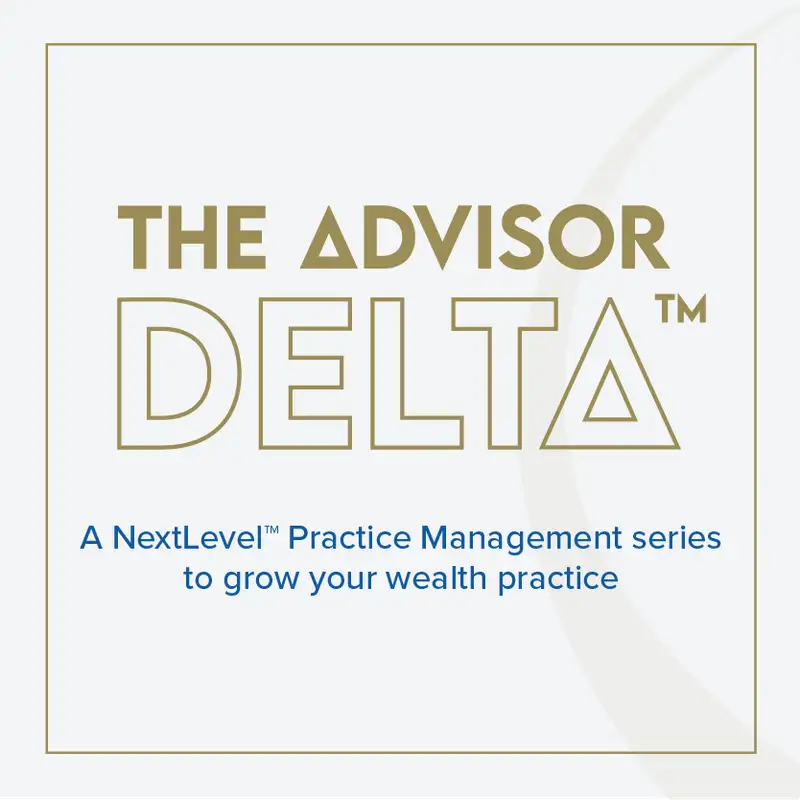Engaging both partners | The case for inclusive financial conversations
Narrator 1: Welcome to The Advisor Delta™, the practice management podcast dedicated to helping investment advisors grow their business and reach their goals. Whether you’re looking to scale your practice, streamline operations, adapt to emerging technology, or deliver value to clients - this is the place for actionable insights, thoughtful leadership and innovative strategies. Brought to you by Worldsource Wealth Management. Let’s dive in!
Narrator2: In our last episode we explored how advisory teams can use AI to enhance their practices. Our podcast team did just that! This episode was researched and written by the NextLevel Practice Management team and is narrated using an AI-generated voice. Every effort has been made to ensure the accuracy and relevance of the information presented.
Michael: Here’s a stat that should stop any advisor in their tracks: According to a survey by McKinsey & Company, 70% of widows leave their financial advisor within a year of their spouse passing. And let’s be honest — that’s not about performance. It’s about connection.
Hello and welcome to another episode of The Advisor Delta! I’m Michael Reyes, guest narrator of today’s episode. Today we’re digging into something both simple and incredibly overlooked — involving both partners in financial conversations.
This is one of those practice habits that separates advisors who retain families across generations from those who lose a household the moment circumstances change. So, let’s explore why this matters, why it’s urgent — and most importantly, how to put it into practice.
Communication, or the lack of it, remains one of the most common reasons clients decide to leave. And more often than not, that breakdown happens because advisors haven’t engaged both members of the household.
For a long time, financial advice was tailored to whoever showed up — often the partner who earned more or expressed more interest in investing. Historically, that’s typically been men. But that dynamic has changed dramatically.
Today, Canadian women control over $2.2 trillion in financial assets. And according to CIBC Economics, that number is expected to double by 2030, as more women inherit wealth, grow businesses, and lead households.
On top of that, financial decision-making has become far more shared. In dual-income households, it’s not just one partner driving the plan — they’re making decisions together.
And yet, too often, only one partner is truly being engaged. That’s a missed opportunity — and frankly, a business risk.
Let’s go back to the first stat I shared: 70% of widows switch advisors. Why? Because they didn’t feel seen. They didn’t feel heard. They weren’t part of the conversation — until it was too late.
Life changes. A spouse passes away, couples separate, roles within households shift. And when those changes happen, the partner you never really got to know could suddenly be the one in charge. If there isn’t trust on both sides of the relationship, that client — and the assets that come with them — could walk out the door.
When you don’t build a relationship with both partners, you’re not just ignoring one half of the household — you’re creating vulnerability in your book. Clients are more likely to stay when they both feel like you’re their advisor. When they both trust you.
And it’s not just about retention. It’s about confidence. Studies consistently show that women, for example, report lower financial confidence — not because they lack capability, but because they haven’t been invited to engage.
When you take the time to involve both people, you build empowerment. You build loyalty. You build better plans. This also opens the door to next-gen relationships.
Heirs, especially adult children, are far more likely to move assets if they don’t have a connection to the current advisor. It creates a leaky bucket — new clients come in the front door, but assets quietly flow out the back. If you’ve only built a rapport with one partner, how do you expect to connect with their adult children? Or navigate a transition when it comes?
I f your client strategy is still built around the idea of primary” and secondary clients, you’re falling behind. This next wave of clients expects a more inclusive, collaborative experience. If you don’t meet them where they are, someone else will.
So, what does it look like in practice to engage both partners? It’s not complicated — but it does require intention.
First, redefine who the client is. It’s not just the person who reached out or who has the bigger portfolio. It’s the household. Every time.
Second, extend the invite — literally. When you book a meeting, ask if both partners will attend. Not as a “nice to have,” but as the default. Don’t assume disinterest. Sometimes, people have been excluded for so long, they don’t think it’s for them.
Third, adapt your language. Are you using jargon that only one partner understands? Are you addressing one person more than the other? These are subtle signals that tell someone whether they belong in the conversation. Make eye contact with both. Ask follow-up questions to both. Use examples that speak to their shared goals.
And here’s a big one — start early. Don’t wait until retirement, estate planning, or a health event to bring in the other partner. If you make it part of your process from the very first meeting, it becomes normal. And it becomes powerful.
This approach also lays the groundwork for building next-generation loyalty. By engaging both partners early and consistently, you open doors to conversations about family, legacy, and values. That makes it easier to bring heirs into the fold and establish relationships before assets move. And when the time comes — whether through retirement, estate transitions or life’s inevitable changes — you’ll already have the trust you need to carry the relationship forward.
After all, you’re managing more than portfolios. You’re managing trust. And trust isn’t built through numbers alone — it’s built through intentional, human connection. Advisors who succeed in the next era will be those who serve the whole household, not just the most vocal member. They’ll be the ones who treat every voice as important, build continuity, and create an experience clients want to stay with — even through life’s hardest transitions.
So if you’re listening to this thinking, “There are a few clients I need to rethink,” that’s a good thing. It means you care enough to grow, to lead, and to serve people fully — not partially.
And if this episode helped shift your mindset, share it with a colleague. Because this is the kind of practice habit that helps all of us do better — together.
Thanks for tuning in, until next time!
Narrator 1: Thanks for tuning into The Advisor Delta™! We hope you found today’s episode valuable to supporting your practice. For more episodes and insights, don’t forget to subscribe and visit us at www.worldsourcewealth.com. And remember, together, we can take your practice to the NextLevel™. Until next time!
Worldsource Financial Management Inc. (a mutual fund dealer) and Worldsource Securities Inc. (an investment dealer), are divisions of Worldsource Group of Companies Inc., operating as Worldsource Wealth Management. The views and opinions expressed in this podcast are those of the participants only. This podcast is for informational purposes only and does not constitute financial, legal, or professional advice. Listeners are encouraged to seek professional guidance for their specific needs. Worldsource Wealth Management does not endorse any products, services, or companies mentioned in this episode.

